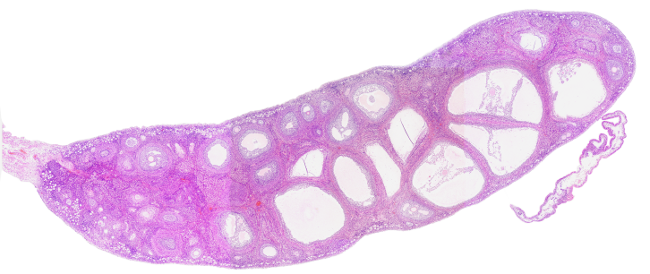Animal organs. Reproductive.
OVARY

Species: rabbit (Oryctolagus cuniculus).
Technique: paraffin embedding, PAS-Haematoxylin.
Structurally, the ovary consists of cuboidal epithelium, tunica albuginea, cortical region and medulla.
The ovarian epithelium is a mono-layer of cuboidal cells lining the outer surface of the ovary (not indicated in the image). It is not derived from the ovary, but from mesothelium.
Tunica albuginea is a layer of dense fibrous connective tissue with fusiform cells. It is more dense than the tunica albuginea covering testis. The function of tunica albuginea is mostly protection.
The ovarian cortex is made up of stroma, which is connective tissue containing a greater amount of cells when compared with the extracellular matrix. The stroma of the ovary contains reticular and collagen fibers and is highly irrigated by blood vessels. Ovarian follicles are found in the stroma. They can be found in different developmental stages, most of them are primordial follicles located under to the tunica albuginea.
Medulla is the inner part of the ovary, surrounded by the ovarian cortex. The boundary between medulla and cortex is not clearly visible. Medulla is loose fibroelastic connective tissue containing abundant blood vessels, lymphatic vessels and nerves. All of them enter the ovary through the hilum. There are no ovarian follicles in the medulla.
In humans, each ovary is attached to other structures by the so-called ligaments. The upper part of the ovary is attached to the peritoneum, the wall of the pelvis, by the suspensory ligament. The posterior portion of the broad ligament of the uterus forms the mesovarium, which also supports the ovary. Through these last two ligaments, nerves and blood vessels enter and leave the ovary. The lower part of the ovary is attached to the uterus by the utero-ovarian or ovarian ligament.
